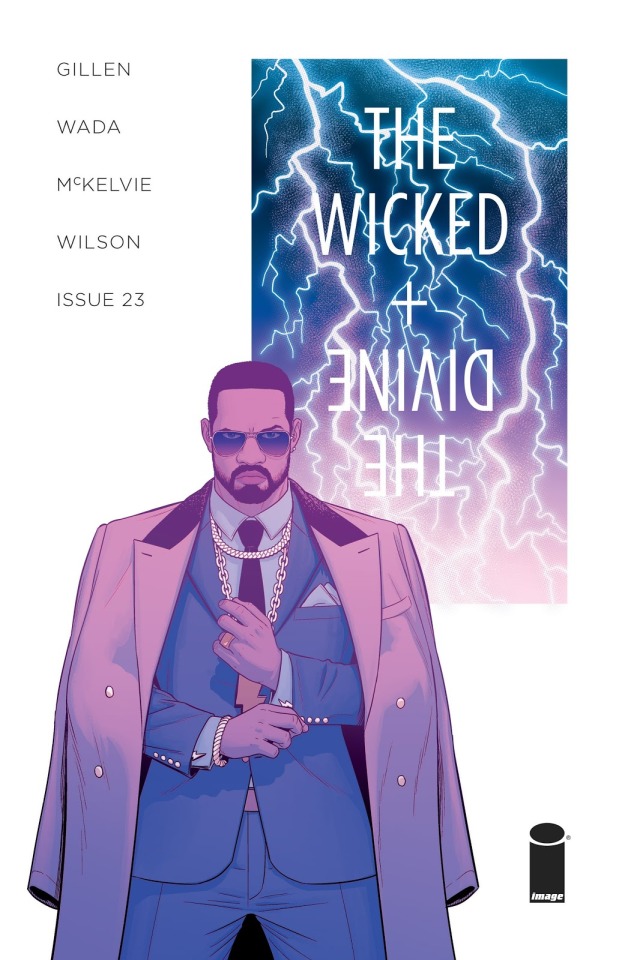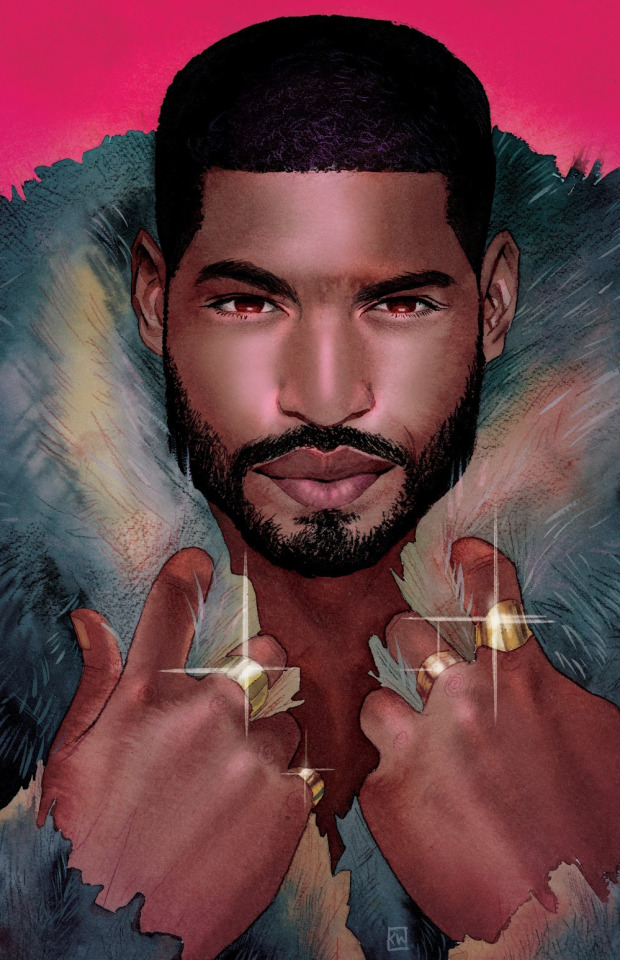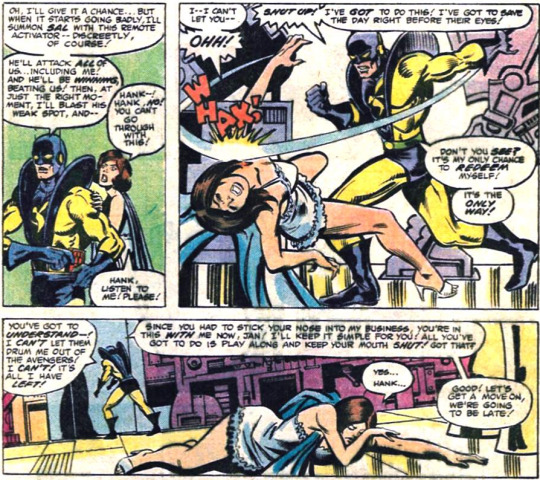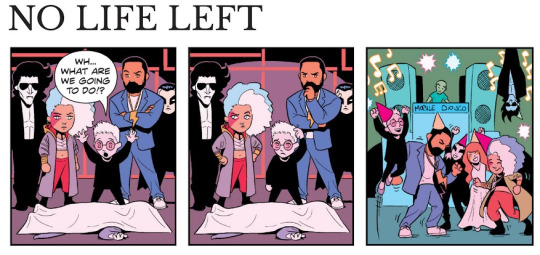#finding hank/jan or just hank in general is A WHOLE MISSION
Explore tagged Tumblr posts
Text
you know your down bad when it comes to looking for fanfic on livejournal
#literally help#finding hank/jan or just hank in general is A WHOLE MISSION#fight for my life everyday#livejournal is my only hope now#but hey man i got really good a google searches in my years#but livejournal is a whole new low#hank pym#janet van dyne#help
9 notes
·
View notes
Text
THE WICKED + THE DIVINE #23: PROFILES IN PLUMAGE

LIFE AFTER MOMMY
While Issue 23 is in a sense a prelude to the arc proper, magazine-style profiles of our Pantheon post-Blood Blister-Ananke-Pop!, one of the great elements of the issue is how it lays out the new status quo within interviews that are the fruit entirely of online role play between Kieron and the interviewers. In other words, the interviewers didn’t have a sense of the story goals, they were just approaching their subjects the way they would in real life, and it was up to Kieron to improvise in a couple key notes – Baal as now Responsible Father Figure/Super Hero who is Going to Stop the Great Darkness and Wear Suits**; Laura as Maybe Actually the Destroyer After All Tho; Morrigan receding into the Undeworld with Baphomet; Ammy’s continued insistence that everything is going to turn out super great for everybody; Woden making a machine to “mimic” people’s powers (see: things that will also work out super great for everybody); oh, and everybody’s still going to die, tick tock.
It’s all a pretty big gamble and it works really really well.
**Just realizing, the guy who makes it his mission in Imperial Phase to protect Minerva is simultaneously quietly killing children. Wow I don’t know how to feel about any of that.
TOMATO, TOMATO
What is this thing we’re reading, issue #23? Is it a comic book recreating itself for an issue as a magazine in order to do something fun and different and also expand the whole “gods viewed as celebrities” concept, show us how the Pantheon are viewed by the wider world?
Certainly that’s how it presents itself. And I dare you to find an issue of another book that does that as well, from layout to shot selection to the kinds of narratives it weaves. And other than the Chris Eliopolis-style three panel strip that ends the issue, and maybe Jamie’s four panels depicting Ananke’s death, there’s not a lot about what goes on within the issue that seems to resemble the storytelling methods of a comic.
But its cover is 100% comic book. We’re given an issue number, the title of the comic, the creative team, the production company. The page dimension are also those of every other issue of the series. And the cover design, Baal against the white background, as though having escaped the comic book frame which now hangs over his shoulder, is the design for the Imperial Phase run of issues.
The back cover fronts (backs?) the magazine vibe, replacing the series’ normal quote from within the book with an advertisement for a Persephone-branded phone. (I have to believe in a world where the ring tone is “Persephone is in Hell.”) But even there, if you want to be picky, you’ve got the bar code and comic book rating in the bottom right.
So it’s a comic book, right, doing celebrity rag really well and why am I wasting your time debating about this. But then there’s this... even if it’s not in a way like pretty much any comic book the art of the issue does generate story, in the way that magazines of its variety do, costume plus setting plus pose revealing character and plotline.

And not only that but the fullness of the story being told in each article and the issue as a whole is a result precisely as a result of the interactions between art and text. Indeed, the very choice of photos first to take and then to use emerges out of both the text of the story and the pre-interview idea for the story that the writer or editor brought.
Clearly issue 23 is the band we love at the top of their game innovating even further and making us think that much more. But maybe it’s also a way of highlighting not that a comic can be a magazine, but that in the way they deliver story, magazines are actually a kind of comic books themselves.
WHO TO GET TO WRITE YOUR PROFILE IF YOU’RE NOT A TOOL
Kevin Wada’s art is just fantastic, both spot on for the kind of magazine the issue is trying to present and also with just the perfect shot selection for the characters.
That two page spread of Baal or the crazy shot of Woden. Wow.

But for me the gold of the issue is the fresh insights the article authors bring to the characters.
“It’s why fans love her,” Leigh Alexander writes of the Morrigan. “She creates spaces where it all feels inevitable, and therefore okay. Or definitely, assuredly not okay, so you can stop pretending, You can stop struggling. Or you can only struggle. Either way it’s a relief.” The blessing of the Morrigan, yes it’s a nightmare, you’re right, and with that truth, an easing of the pain. (I love all the articles, but Alexander’s is particularly wonderful. The feeling she has for the Morrigan gives the piece such pathos.)
Or here’s Dorian Lynskey, writing about Baal. “This, then, is Baal’s spin for the day: there will be a plan. We mortals might not know what it is, it may not even be decided yet, but there will be one. DO I believe it? I’m not sure. But I believe that Baal believes it. After so much blood and chaos, he needs to believe it.”
(Did Lynskey have any idea of the secrets Baal was hiding? I don’t think so. And yet knowing what we know not, could his piece be any more dead on?)
In her profile of Woden, author Laurie Penny says “He takes women and turns them into videogame cheesecake. He takes women and turns them into something less than human, something comprehensible and controllable, with clear win conditions.”
She also kids that his workshop is like the Batcave, and follows with another incredibly prescient remark: “’Where’s Alfred? Or...no, hang on. You’re Alfred.”
Mary HK Choi’s insistence on often calling Lucifer by her birth name, which at first works as a refusal to take the claims of godhood as anything more than as millennial celebrity publicity stunt; but then becomes part of insisting on Luci’s innocence and vulnerability: “Lucifer if perfect right now – vibrant and happy. And while there is a humane aspect to the fatalistic branding, the finite relevance that is the reality of the celebrity industrial complex in the age of social media, it’s still super sad.
“When she’s skipping to the mall, shudder at how her parents (unrepentant Beatles fans) conceived her on the night of a Blur gig...she is very much a kid. A kid swaggering to impress you and thousands of people for whom everything is performance.”
(Also, we get that great quote from Kieron, “Being the devil is knowing you’re lost.” Rather than Purveyor of Lies, Lucifer once again as the one who understands the lie within it all.)
Lastly, here’s Ezekiel Kweku, after hearing Ammy explain away Ananke’s death: “She looks preternaturally serene, godlike once more. For some reason, this makes me even sadder.”
(“She doesn’t want you to see in her a deconstructed divinity, she wants to appear as whole and uncomplicated as an undivided beam of light,” is so perfect as sentences go I would be filled with a jealous rage if I could stop enjoying it.)
NO BUT SURE ANOTHER WOODY ALLEN MOVIE IS FINE THO
I do this newsletter on pop culture and spirituality called Pop Culture Spirit Wow. (Join us and we can rule the galaxy forever.) And the week Avengers: Infinity War came out I did a whole thing on the history of the Avengers, including some of their most iconic storylines.
And in doing research, I stumbled upon this post from former Avengers writer Jim Shooter, who insists that Hank Pym “was not a wife-beater”. The famous moment where Pym hits Janet van Dyne, he said was actually the mistake of the artist. “In that story (issue 213, I think),” Shooter writes, “there is a scene in which Hank is supposed to have accidentally struck Jan while throwing his hands up in despair and frustration—making a sort of ‘get away from me’ gesture while not looking at her. Bob Hall, who had been taught by John Buscema to always go for the most extreme action, turned that into a right cross!” And it was too late to fix it, so they had to go with it.
Years later, Bob Hall responded, saying Shooter “had never said he didn’t like the slap panel”, but that he could believe he’d made a mistake, because he was young and didn’t know what he was doing.
But I don’t know, this is a pretty different from an “accidental slap”:

Also, what precipitates this terrible moment is Pym on trial for having seemingly shot a woman in the back (turns out she was a robot) and feeling a lot of pressure. The issue features Tigra worrying about Jan and wondering why she stays with him. “Don’t you see you’re worth ten of him?” she asks.
And after his “accidental slap” he flips out in court, ultimately sending in a robot to save him.
So I don’t know, actually an accidental slap feels a lot less likely than what was drawn. (Actually it feels exactly like what someone who just hit a woman says to try and get away with it.)
Once it “happened”, Shooter and Marvel were “stuck” with it (#TheRealVictims), and Shooter had to rethink where he was headed with the characters. Jan files for divorce next issue, in fact.
If you look at the history of comics, you won’t find many moments like this, at least not at the Big Two. Men do not hit women.
Unless they have powers, that is. Then it’s kind of all fair, or at least occasionally permissible. And it never comes up in later conversation. It’s just the way things are. She was super strong, she hit me first, of course it’s okay.
In both the Morrigan and Baal pieces the characters talk about Baal having hit her. That attack happened twelve issues ago (when you include the 1831 special), and it’s still considered a significant ongoing story point for both characters.
Once again, WicDiv making us consider things that the world kind of ignores. (Or even enjoys.)
DENIAL, THE NEW FRAGRANCE
The very last beat of this issue, the wacky cartoon, is maybe the hardest hitting punch of all.

They’ve been through all this craziness, they’ve found out they were being manipulated all this time, and they just straight murdered someone. So what do they do now?
What else? They party.
It’s like the Danger Laura Wilson warning of the first two arcs, but now applied to the whole group, and just as firmly ignored. The only one who really seems to understand at all it is Luci, and she’s dead, er, a living head stuck in a cave we won’t know about for another year of issues.
4 notes
·
View notes